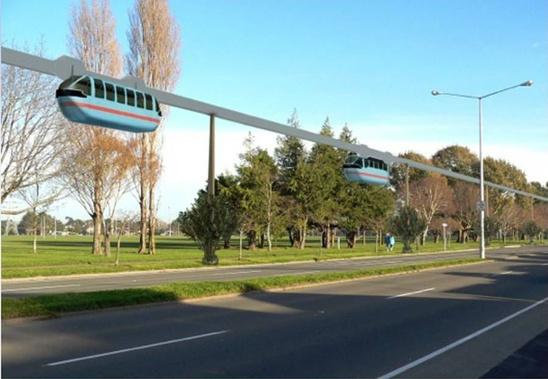
A $560 million rapid transport system called SkyCabs has been mooted as the answer to Tauranga's increasingly congested roads.
''It would be iconic for Tauranga to have something like this,'' the council's transport committee chairman Rick Curach said.
He was responding to a presentation yesterday by SkyCabs designer and Auckland architect Hugh Chapman who said the system would halve the travelling time of cars and buses at peak times.
''It is a system that could really change transport patterns.''
Tauranga could become the first city in the world to introduce the patented system that differed from traditional monorail systems by having driverless cabs hanging underneath rather than sitting above a beam raised eight to 10 metres above city footpaths.
Councillor Curach promised Chapman that the committee would offer feedback on SkyCabs once it had discussed the concept at a later date.
''We will be in touch.''
Mayor Greg Brownless liked that SkyCabs' funding estimates did not call for operating subsidies from city ratepayers. He described the plan as ''futuristic''.
Chapman proposed that the Government would contribute $280m of the cost to build the four lines. A total of $224m would be shared by private equity and bank loans and $56m would come from the new Regional Development Fund.
The cost included stations spaced at every 750m to 1km of line, with the cabs averaging 60km/h.
Chapman said construction would cost about $21m per kilometre which was up to two-thirds less than alternatives like busways and bus lanes, light rail, a standard monorail and personal rapid transit.
There would be enough cabs to move 4800 seated passengers per hour in each direction - the equivalent of almost two lanes of flowing motorway traffic.
The system had the potential to move 9000 people per hour seated and standing in the cabs. Peak time frequency would be 15 to 20 cabs per hour, with waiting times of 30 seconds to a maximum of four minutes.
Chapman said the eight-seater electric cabs would run on each side of the beam, with economies of scale from the modular construction.
The longest line of 8.7km would run between the cruise ship terminal and the CBD, via Totara St, with a link to the airport. The other side of the Mount Maunganui connection to the cruise ship terminal was a 5.1km line via Maunganui Rd and a link to the airport.
The shortest line at 3km was Maunganui Rd from Hewletts Rd to Baypark stadium.
On the city side, a 7km line would run from First Ave to Barkes Corner along Cameron Rd. A future 8km line was Otumoetai Rd linking with Cameron Rd via Chapel St and Waihi Rd.
Chapman envisaged SkyCabs could capitalise on the development of a specialist mountain bike track on spare land at the back of the racecourse at Greerton.
He said fares would be ''a bit above'' existing BayHopper bus fares although he did not have any figures.
Councillor Larry Baldock said Chapman would need to do a lot more work to convince him that SkyCabs could run without subsidies.
Asked whether a fifth line from 15th Ave and Turret Rd to Welcome Bay could be added, he said SkyCabs was very adaptable.
''It would be marvellous for getting people into the centre of the city.''
Take your Radio, Podcasts and Music with you









